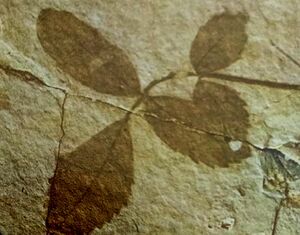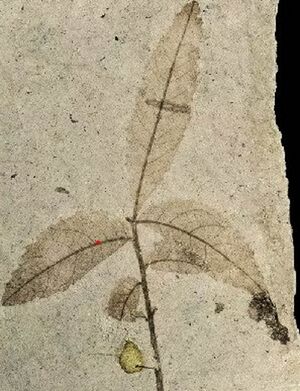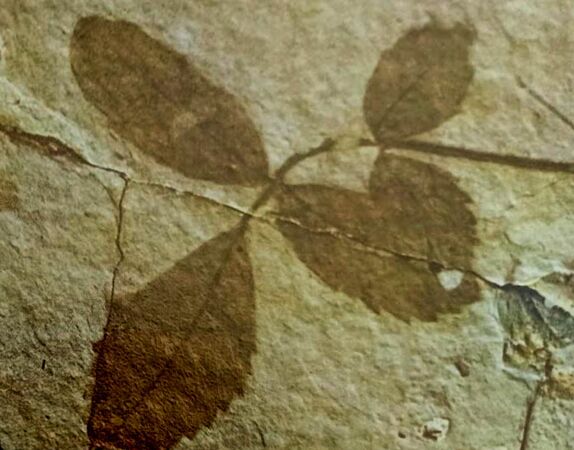Rosa wilmattae Cockerell
Fossile-Rose, 1908 - beschrieben vom Paläobotaniker/ described by the palaeobotanist/ décrit par le paléobotaniste Theodore Dru Alison Cockerell, USA
Eltern/ parentage/ parents: Botanische Rose/ Wild Rose/ Rosier botanique
Vermutliche Synonyme/ Presumed synonyms/ synonymes présumés: Rosa hilliae Lesq., Rosa dubia C.O.Weber
Die Synonyme wurden von den Botanikern/ The synonyms were described by the botanists/ Les synonymes ont été décrits par les botanistes Daniel Isaac Axelrod, USA, Shigeru Miki, Japan, Hermann Engelhardt, Deutschland, Charles Arthur Hollick, USA, Ralph Works Chaney, USA, Frank Hall Knowlton, USA, Gábor (Gabriel) Andreánszky, Ungarn, Oswald von Heer, Schweiz, Theodore Dru Alison Cockerell, USA, Hsen Hsu Hu, China, Toshimasa Tanai, Japan, Wladyslaw Szafer, Polen
Allgemeines • Preface • Remarques
Benannt hat Theodore Dru Alison Cockerell die fossile Rose zu Ehren seiner Frau Wilmatte Porter Cockerell (* 28.7.1870, † 1.01.1957)[1]. Sie war eine amerikanische Entomologin und Highschool-Biologielehrerin, die eine große Anzahl von Insekten und anderen Organismen entdeckte und sammelte. Der Fund stammt aus dem Oligozän[2], ist also 33,9 - 23,03 Mio. Jahre alt.
Theodore Dru Alison Cockerell named the fossil rose in honour of his wife Wilmatte Porter Cockerell (* 28.7.1870, † 1.01.1957)[1]. She was an American entomologist and high school biology teacher who discovered and collected a large number of insect specimens and other organisms. The find dates from the Oligocene[2], i.e. 33.9 - 23.03 million years old.
Theodore Dru Alison Cockerell a nommé la rose fossile en l'honneur de sa femme Wilmatte Porter Cockerell (* 28.7.1870, † 1.01.1957)[1]. Entomologiste américaine et professeur de biologie dans un lycée, elle a découvert et collecté un grand nombre de spécimens d'insectes et d'autres organismes. La découverte date de l'Oligocène[2], c'est-à-dire de 33,9 à 23,03 millions d'années.
Originale Beschreibung • Original description • Description originale
Übersetzung:
Rosa wilmattae sp. nov.
Tafel VII, Fig. 14.
Muster im Am. Mus. Nat. Hist.
Eine Art vom Typ R. sayi, die Blätter mit fünf Fiederblättchen; Nebenblätter sehr schmal, im Fossil nicht sichtbar; Blatt 55 mm. lang, davon 21 mm. als Blattstiel; erstes Paar Fiederblättchen klein, oval, 10 mm. lang, etwa 6 ½ breit, fast sitzend; zweites Paar etwa. 7 ½ mm vom ersten Paar entfernt, langoval, ca. 16 mm lang und 7 ½ breit; Fiederblättchen an der Spitze 5 mm über das zweite Paar hinaus, langoval, mit keilförmiger Basis, 21 mm lang, 10 mm breit; Fiederblättchen grob und einfach gezähnt.
Ein anderes Exemplar (in Univ. of Colo.) hat größere und breitere Fiederblättchen; das zweite Paar ist etwa 10 ½ mm breit.
Die andere amerikanische Tertiärrose (ebenfalls aus Florissant), R. hilliae Lx., stellt die moderne R. setigera dar und hat nur drei Fiederblättchen und sehr deutliche Nebenblätter. Die Art R. wilmattae hat oberflächlich gesehen eine leichte Ähnlichkeit mit Weinmannia roscaefolia Lx. Die letztgenannte Art wurde später von Lesquereux zu Rhus gestellt, kann aber wegen ihrer Ähnlichkeit mit der neuseeländischen W. sylvicola ebenso gut in Weinmannia verbleiben. Würde sie in Rhus verbleiben, müsste der Name geändert werden, da er früher in dieser Gattung verwendet wurde.
Rosa wilmattae sp. nov.
Plate VII, Fig. 14.
Type in Am. Mus. Nat. Hist.
A species of the R. sayi type, the leaves with five leaflets; stipules very narrow, not apparent in the fossil; leaf 55 mm. long, of which 21 mm. is petiole; first pair of leaflets small, oval, 10 mm. long, about 6 ½ broad, nearly sessile; second pair about. 7 ½ mm. from first pair, long-oval, about 16 mm. long and 7 ½ broad; apical leaflet 5 mm. beyond second pair, long-oval, with a cuneate base, length 21 mm., breadth 10; serrations of leaflets coarse and simple.
Another specimen (in Univ. of Colo.) has larger and broader leaflets; the second pair about 10 ½ mm. broad.
The other American Tertiary rose (also from Florissant), R. hilliae Lx., represents the modem R. setigera, and has only three leaflets, and very distinct stipules. R. wilmattae has a slight superficial resemblance to Weinmannia roscaefolia Lx. This latter species was later referred by Lesquereux to Rhus, but it may as well remain in Weinmannia, on account of its resemblance to the New Zealand W. sylvicola. If retained in Rhus, the name would have to be changed, having been earlier used in that genus.
Traduction:
Rosa wilmattae sp. nov.
Table VII, Fig. 14.
Type en Am. Mus. Nat. Hist.
Espèce du type R. sayi, feuilles à cinq folioles ; stipules très étroites, non apparentes sur le fossile ; feuille de 55 mm de long, dont 21 mm de pétiole ; première paire de folioles petite, ovale, 10 mm de long, environ 6 ½ de large, presque sessile ; deuxième paire d'environ. 7 ½ mm. de la première paire, longue-ovale, environ 16 mm. de long et 7 ½ de large ; foliole apicale 5 mm. au-delà de la deuxième paire, longue-ovale, à base cunéiforme, longueur 21 mm., largeur 10 ; dentelures des folioles grossières et simples.
Un autre spécimen (à l'Univ. de Colo.) a des folioles plus grandes et plus larges ; la deuxième paire est large d'environ 10 ½ mm.
L'autre rosier tertiaire américain (également de Florissant), R. hilliae Lx, représente le R. setigera moderne, et n'a que trois folioles et des stipules très distinctes. La R. wilmattae a une légère ressemblance superficielle avec la Weinmannia roscaefolia Lx. Cette dernière espèce a été plus tard référencée par Lesquereux dans Rhus, mais elle pourrait tout aussi bien rester dans Weinmannia, en raison de sa ressemblance avec le W. sylvicola de Nouvelle-Zélande. S'il est maintenu dans Rhus, le nom devra être changé, car il a déjà été utilisé dans ce genre.
Fundort • Find location • Lieu de découverte
Das Rosenblatt wurde vom Ehepaar Cockerell in den Florissant Fossil Beds[3] in Teller County, Colorado, USA gefunden.
The rose petal was found by Mr and Mrs Cockerell in the Florissant Fossil Beds[3] in Teller County, Colorado, USA.
Le pétale du rosier a été trouvé par le couple Cockerell dans dans les Florissant Fossil Beds[3] dans le comté de Teller, Colorado, États-Unis.
- Rosa wilmattae
Zum Vergrößern anklicken • click to enlarge • cliquez pour agrandir
↑ Nach oben • Top • Vers le haut ↑
Einzelnachweis • Footnotes • Notes
Weblinks • External links • Liens externes
Literatur • Literature • Littérature
- Theodore D. A. Cockerell, The fossil flora of Florissant, Colorado, 1908 Seite 94, 95 - Text u. Plate VII, Fig. 14
- Herman F. Becker, The fossil record of the genus Rosa, 1963 Rosa wilmattae



